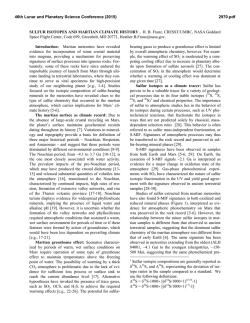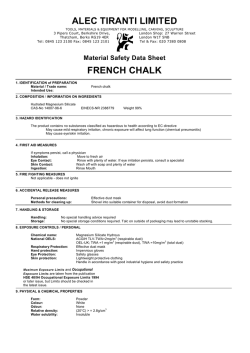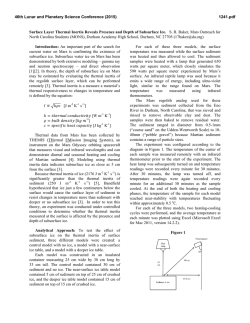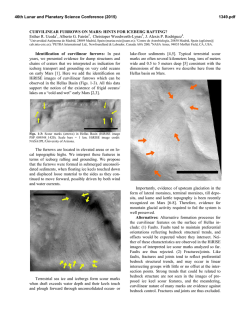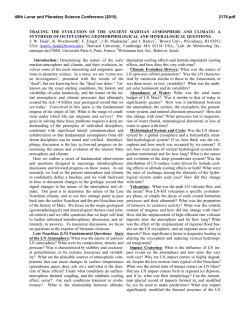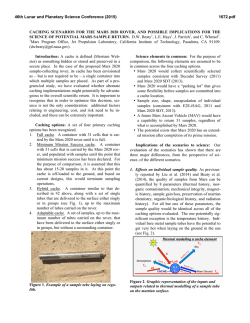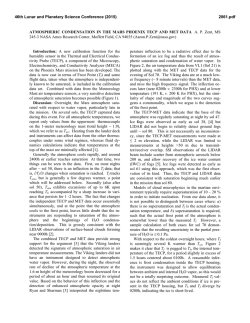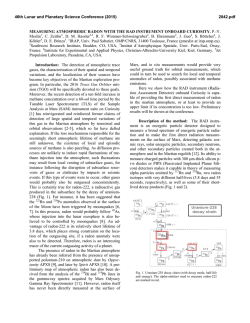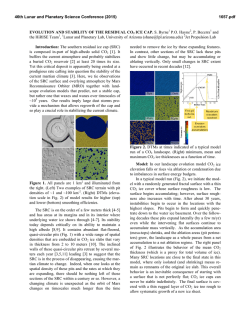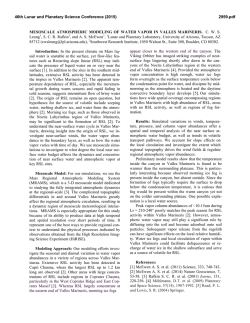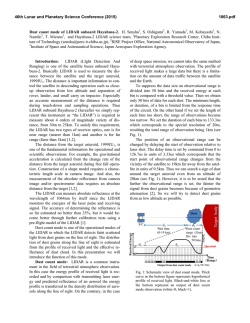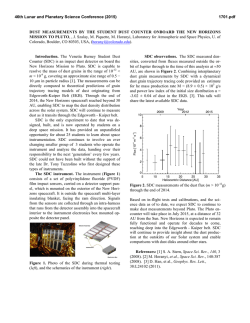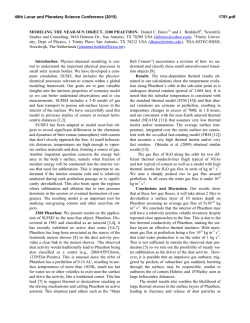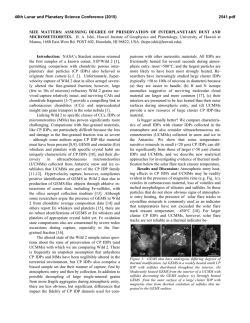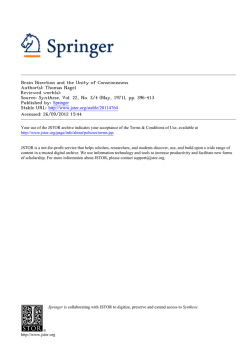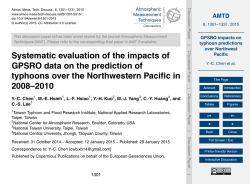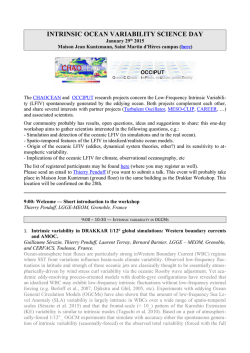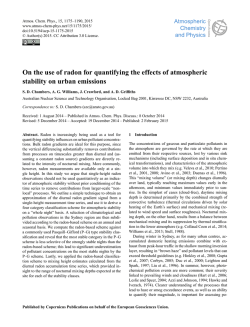
ASSIMILATING MARTIAN ATMOSPHERIC CONSTITUENTS USING
46th Lunar and Planetary Science Conference (2015) 2390.pdf ASSIMILATING MARTIAN ATMOSPHERIC CONSTITUENTS USING A GLOBAL CIRCULATION MODEL. S. R. Lewis, L. J. Steele, J. A. Holmes, and M. R. Patel, Department of Physical Sciences, The Open University, Walton Hall, Milton Keynes, MK7 6AA, UK ([email protected]). Introduction: The technique of data assimilation is employed in a novel way for a planetary atmosphere to perform a complete spatial and temporal anaylsis of martain atmospheric constituent data over periods of several Mars years. Observations of martian atmospheric constituents, generally made from orbiting spacecraft, are often sparse and incomplete. A global circulation model can be used to predict the transport, phase changes and chemical reactions that these species undergo. If constrained by obervations, it can then provide a consistent interpolation to unobserved regions and, in principle, a useful a priori for future retrievals. Furthermore, any consistent mis-fit between the model predicitions and new observations can be used to identify potentially important physical processes that are missing from the model, including inferring the presence and location of sources and sinks. The scientific impact possible by applying data assimilation techniques to retrieved observations including those of water vapour, water ice and ozone will be demonstrated, as well as some of the contraints on the data sets required to make the process useful. Data Assimilation: Data assimilation, the combination of observations and numerical models which provide physical constraints, and organize and propagate the observational information that is introduced, is commonly used as a means of analysing large atmospheric and oceanic observational data sets for the Earth [1] and notably to form initial states for numerical weather forecasts [2]. Data assimilation also offers significant potential advantages for the analysis of atmospheric data from other planets, which have been demonstrated by the successful assimilation of thermal and dust opacity data over a period of up to eight martian years (about fifteen Earth years). This includes thermal and dust opacity observations from the Thermal Emission Spectrometer (TES) aboard NASA Mars Global Surveyor [3,4] and Mars Climate Sounder (MCS) observations from NASA Mars Reconnaissance Orbiter (MRO). While previous work, with both the present [3] and other data assimilation schemes [5], has largely focussed on assimilation of temperature and total column dust opacity in order to constrain the atmospheric circulation, we have now implemented an extension to the procedure to include three-dimensional dust transport, water cloud aerosol and chemical species. This will enhance our understanding of the dynamics of the martian atmosphere and provide a consistent analysis over several different martian years from different instruments using the same numerical model. Water Vapour: The Mars global climate model (MGCM) can include a full water cycle, with coupling to the model radiation scheme possible through the increased opacity of water ice clouds, which in turn affects the model heating. Retrievals of water vapour column data from TES were assimilated into the model[6], reducing the the global water vapour column error in the MGCM to around 2–4 pr-µm depending on season. An analysis of the atmospheric water transport revealed the importance of large-scale stationary waves and topographically-steered flows in moving water vapour southward from the northern hemisphere winter cap and the importance of outlying frost deposits around the north polar cap in producing local atmospheric maxima during northern hemisphere summer. A net inter-hemispheric transport of water toward the northern hemisphere was detected, particularly associated with a regional dust storm in late fall and early winter. Water Ice: Assimilation of water ice opacities is more challenging, not least because there is generally relatively little water ice compared to water vapour in the atmospheric column and so it is harder to constrain the model through that field alone: the MGCM is able to rapidly ‘reject’ any observation by conversion between the larger reservoir of water vapour and ice. There are, however, more water ice opacity measurements, covering a longer period of time and so we have attempted the procedure using MCS opacity data which includes some vertical profile information [7]. The water ice opacity profiles are carefully used to build a four-dimensional time-space map of water ice clouds, which is then used by the GCM to produce the radiative forcing associated with clouds. This procedure allows clouds to be inserted into the model at the correct time and location, producing the most realistic state from which to analyse cloud radiative effects. The results show that tropical clouds have a greater impact on the local atmosphere than polar hood clouds, increasing diurnally-averaged temperatures at the 10 Pa level by around 10–15 K. Tropical clouds also strengthen the meridional overturning circulation, leading to increased temperatures in the polar warmings by around 6–8 K, and increased temperatures in the tropics by around 2 K due to increased dust loading. The positions and wind speeds of the tropical and high- 46th Lunar and Planetary Science Conference (2015) 2390.pdf latitude jets are also modified through changes to the meridional temperature gradients. Figure 1: Time- and zonal-mean temperature differences TIA − TCR (a,b) and TIA − TTA (c,d) for northern hemisphere summer and fall of MY 30. Black contours show the visible ice opacity, with values of 0.005, 0.01, 0.02 and 0.03. Grey shading represents topography. These results are illustrated in Fig. 1, which shows zonal-mean atmospheric temperature differences between an assimilation including the ice opacities (subscript IA), an assimilation using thermal and dust opacity data alone (subscript TA), and a control run (subscript CR) based on the observed dust opacity but otherwise with a free-running MGCM. Comparison between the CR and IA allows the radiative impact of clouds to be investigated, while comparison between the IA and TA allows the performance of the IA and any remaining temperature biases to be assessed. Trace Gas Assimilation: The MGCM has the ability to transport many independent tracers. As well as purely passive transport, the MGCM includes the option of a coupled photochemical model, derived and expanded from [8, 9]. The Mars Color Imager (MARCI) [10] aboard MRO provides near-daily global mapping of ozone column concentration extending the currently available ozone data set [11]. These data were used alongside MCS temperature and dust opacity observations, and a fully comprehensive analysis of the ozone cycle has been attempted [12]. Some preliminary results are illustrated in Fig. 2, showing the northern hemisphere winter polar vortex region. Figure 2: Northern polar stereographic comparison of MARCI observations (top) and assimilated output (bottom) at LS = 343° MY30. Future Work: The data set resulting from a constuent assimilation, if successful, allows a detailed study of the atmospheric state that is not possible using observations or models alone. Future plans for assimilation of forthcoming data sets, such as from 2016 ESA Mars Trace Gas Orbiter, and improvements to the technique used will be discussed. References: [1] Lahoz, W., et al. (eds.) (2010) Data Assimilation: Making Sense of Observations, Springer, Berlin. [2] Kalnay, E. (2003) Atmospheric Modeling, Data Assimilation and Predictability, Cambridge University Press. [3] Lewis, S. R., et al. [2007] Icarus, 192 (2), 327–347. [4] Montabone, L., et al. [2006] Icarus, 185, 113-132. [5] Greybush S. J. et al. [2012] JGR, 117, 11008. [6] Steele, L. J., et al. [2014] Icarus, 237, 97–115. [7] Steele, L. J., et al. [2014] GRL, 41(13), 4471–4478. [8] Lefèvre, F., et al. [2004] JGR, 109, 7004. [9] Lefèvre, F., et al. [2008] Nature, 454, 971–975. [10] Clancy, R. T., et al. [2011] Mars Atmosphere: Modelling and Observation, 337–339. [11] Perrier, S., et al. [2006] JGR, 111, E09S06. [12] Holmes, J. A., et al. [2014] 8th International Conference on Mars, 1298.
© Copyright 2026


